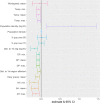Cold and dry winter conditions are associated with greater SARS-CoV-2 transmission at regional level in western countries during the first epidemic wave
- PMID: 34140557
- PMCID: PMC8211690
- DOI: 10.1038/s41598-021-91798-9
Cold and dry winter conditions are associated with greater SARS-CoV-2 transmission at regional level in western countries during the first epidemic wave
Abstract
Higher transmissibility of SARS-CoV-2 in cold and dry weather conditions has been hypothesized since the onset of the COVID-19 pandemic but the level of epidemiological evidence remains low. During the first wave of the pandemic, Spain, Italy, France, Portugal, Canada and USA presented an early spread, a heavy COVID-19 burden, and low initial public health response until lockdowns. In a context when testing was limited, we calculated the basic reproduction number (R0) in 63 regions from the growth in regional death counts. After adjusting for population density, early spread of the epidemic, and age structure, temperature and humidity were negatively associated with SARS-CoV-2 transmissibility. A reduction of mean absolute humidity by 1 g/m3 was associated with a 0.15-unit increase of R0. Below 10 °C, a temperature reduction of 1 °C was associated with a 0.16-unit increase of R0. Our results confirm a dependency of SARS-CoV-2 transmissibility to weather conditions in the absence of control measures during the first wave. The transition from summer to winter, corresponding to drop in temperature associated with an overall decrease in absolute humidity, likely contributed to the intensification of the second wave in north-west hemisphere countries. Non-pharmaceutical interventions must be adjusted to account for increased transmissibility in winter conditions.
Conflict of interest statement
The authors declare no competing interests.
Figures







References
MeSH terms
LinkOut - more resources
Full Text Sources
Medical
Miscellaneous

